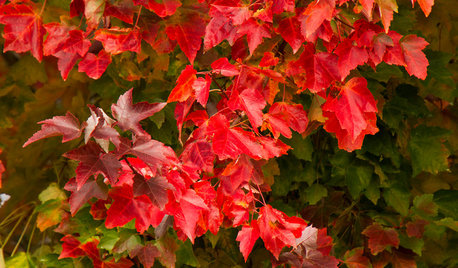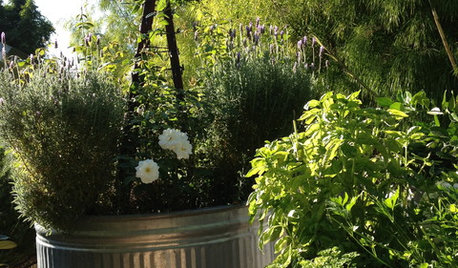large good fast growing shade tree
kept
17 years ago
Featured Answer
Sort by:Oldest
Comments (25)
garden_obsessed
17 years agokept
17 years agoRelated Discussions
Shade tree suggestion - preferably fast growing
Comments (5)Bur oak is native to your area and an excellent shade tree. It grows at a reasonable pace, particularly when it's young and will give you shade in a reasonable period of time. You might also want to consider some of the native maples. Do NOT plant norway maple. I also advise against our native silver maple in home landscapes -- it's just too big and ungainly for that setting. That being said, red or sugar maple are nice choices and I wouldn't even be opposed to the red/silver hybrids. Sycamore is also nice and fairly fast growing. I would recommend ash, but the emerald ash borer problem really prevents that these days. Hackberry would be a good choice, however, as would Kentucky coffeetree or perhaps even one of the Dutch elm disease resistent elm cultivars....See Morebig fast growing shade tree for GA
Comments (14)Catalpa is not invasive in the way the term invasive is meant to be used. While Empress Trees are invasive as the term is meant to be used. Despite appearances, they aren't closely related. Both Catalpa species are listed in Georgia, though it is uncertain what their original range was, as they were widely dispersed by Native American Indians before the arrival of Europeans. If you don't like them, that's fine, but they do fit the criteria you asked for, are very tough, and are native to the SE U.S.. Arktrees Here is a link that might be useful: Catalpa species in the search area...See MoreFast Growing 30-40ft Shade Tree Mid-MI
Comments (4)what about a hawthorn? fruits are small(berry size), flowers nice in the spring. my looks a bit ratty by the end of the summer leaf wize, but then its the end of the summer. berries stay bright red all winter and don't drop until the end of february-- birds will eat them in very late winter. thorns on the limbs are a bit of an issue when you prune-- but otherwise not a problem. after 15 years mine is about 35 foot tall-- just the tops of the branches are in the wires to the house with about a 20-25 foot spread. trunk is about 8" calliper. it started as a 3" stem about 12 foot tall. but took three years before it started to jump in size. diggerb...See MoreNeeding a fast growing shade tree - Toowoomba Queensland
Comments (1)Hi Robyn. Could I suggest that an important consideration is to plant species which have the best chances of survival. For this reason, I'd be very much inclined to go for local species which, naturally, have evolved with the local soil & climatic conditions. To get an idea of which species are local you could visit your nearest patch of relatively undisturbed bushland & take notes. Take along someone with plant identification skills if you don't have these skills yourself. You might also want to talk with the environment office at the Toowoomba Regional Council about the local species which would meet your criteria & might be best suited for your property, especially for the boggy area. I note that Forest Red Gum Eucalyptus tereticornis seems to be local to you. Did you plant that one or is it a remnant of the forest which once covered your property? This species would seem to be one that would be suitable for you as it is fast growing. Silky Oak Grevillea robusta is now rather rare in its natural range which is close to Toowoomba. They naturally grow along creek lines so might grow fastest in your seasonally boggy parts. But they do well in dry conditions. I have a couple of healthy but slow growing ones where I live with an average rainfall of only 475 mm. I believe they're used as a street tree in Alice Springs & there are several very tall specimens in Murray Bridge SA with an average rainfall of about 400mm. Are yours in boggy or dry parts? Or both?...See Morepineresin
17 years agoquirkyquercus
17 years agoDibbit
17 years agokrazyaroider
17 years agoIris GW
17 years agoken_adrian Adrian MI cold Z5
17 years agospruceman
17 years agoscotjute Z8
17 years agobasic
17 years agospruceman
17 years agoalabamatreehugger 8b SW Alabama
17 years agoalexander3_gw
17 years agoalabamatreehugger 8b SW Alabama
17 years agokept
17 years agoDibbit
17 years agoquirkyquercus
17 years agobasic
17 years agospruceman
17 years agowisconsitom
17 years agokrazyaroider
17 years agospruceman
17 years agokept
17 years ago
Related Stories

GARDENING GUIDES9 Low-Growing Hedges That Make Good Neighbors
Define garden areas or borders without blocking the view, with these evergreen shrubs that take kindly to trimming
Full Story
GARDENING GUIDESGrow Your Own Privacy: How to Screen With Plants and Trees
Use living walls to lower your home and garden's exposure while boosting natural beauty in your landscape
Full Story
TREESGreat Design Plant: Acer Rubrum Brings Shade and Beauty
Red maple — a fast-growing, low-maintenance Eastern native — has spectacular fall foliage and early-spring flowers that feed pollinators
Full Story
EDIBLE GARDENSGrow Herbs for Fresh Flavor and Good Looks in the Garden
With sun and a patch of ground, you can have all the fresh flavor you need for cooking right outside your door. Here's how to get started
Full Story
EDIBLE GARDENSHow to Grow Your Own European and Asian Pears
Try these trees for their good looks, delicious fruit and wide range of sizes — plus you can espalier them
Full Story
DECORATING GUIDESFix Those 'Whoopsies': 9 Fast Solutions for Decorating Mistakes
Don't suffer in silence over a paint, furniture or rug snafu — these affordable workarounds can help
Full Story
EDIBLE GARDENSWhy Grow Quince? For Beauty, Fragrance and Old-Time Flavor
Delightfully perfumed fruit and lovely spring blossoms make this apple and pear cousin worth a spot in the garden
Full Story
LANDSCAPE DESIGN7 Great Trees for Summer Shade and Fall Color
These landscape-pro faves straddle the seasons beautifully. Could one enhance your own yard?
Full Story
FRUIT TREESHow to Grow Your Own Persimmons
Sturdy and easy to care for, these trees offer bright fruit through winter — and keeping them in bounds is no sweat
Full Story
EDIBLE GARDENSHow to Grow Your Own Luscious Cherries
Nope, they’re not the easiest fruit to grow. But with spectacular blossoms and pies as possibilities, cherries are sure worth a try
Full Story





spruceman